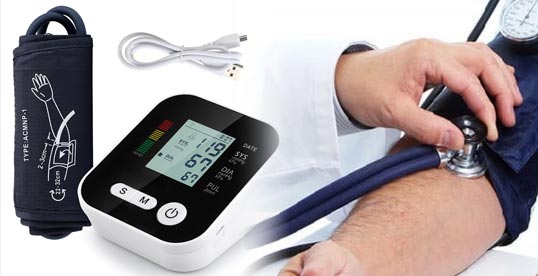What is Blood pressure monitor ?
The ambulatory blood pressure monitor is a portable device that measures blood pressure. It records blood pressure measurements at specific times over a 24-hour period.
The device consists of a cuff connected to a lightweight monitor by a flexible rubber tube. It is inserted into a pouch attached to a belt or shoulder strap. Typically, a blood pressure monitor is worn to confirm a diagnosis of hypertension (high blood pressure).
A blood pressure measurement in the doctor's office or clinic does not always lead to a diagnosis of hypertension or hypotension (low blood pressure). Doctors may prescribe an ambulatory blood pressure monitor for a patient if they suspect hypertension or another blood pressure problem.
An ambulatory blood pressure monitor is a portable external device connected to a special cuff that the patient must wear for 24 hours. The monitor automatically measures and records blood pressure at regular intervals during daily activities - usually every 20 minutes during the day and less frequently at night.
After the device is returned, the recorded data is analysed and reviewed by a specialist, and a report is sent to the treating physician.
Citizen blood pressure monitor
This exam is not covered by the Ontario Health Insurance Program. A fee of $100.00 must be paid by cash or cheque at the time of appointment.
After receiving the referral form from your physician, the Cardiac Imaging Department will contact you directly to schedule an appointment. Please ensure that your contact information is up to date.
The blood pressure monitor will be scheduled in the Cardiac Imaging Department, located in the basement (S level) of the Heart Institute. At the end of the monitoring period, you will need to return the device to the same location.
You will need to wear the blood pressure monitor for 24 hours. Unless otherwise stated, the cuff is programmed to inflate every 20 minutes until 10:00 p.m. and then every hour until 6:00 a.m.
If you experience symptoms such as dizziness, headache or facial flushing, or if you notice an increase in your heart rate, you will need to initiate a manual blood pressure measurement by pressing a button on the monitor.
24 hour ambulatory blood pressure monitor
You will be given a sheet of paper on which to record :
- Your symptoms;
- your periods of intense activity;
- your stressful episodes;
- the time and dose of your prescription medication;
- the time you fell asleep.
At the end of the 24 hour ambulatory blood pressure monitor recording period, you will be asked to turn off the monitor and return it to the Cardiac Imaging Department. The recorded data will be reviewed by a specialist. A report will then be sent to your doctor within 10 working days. Your doctor will discuss the results with you.
THE DIFFERENT TYPES OF Citizen blood pressure monitor
WHAT ARE THE DIFFERENT TYPES OF BLOOD PRESSURE MONITORS?
There are two main types of blood pressure monitors:
- - Electronic blood pressure monitors.
- - Manual sphygmomanometers.
ELECTRONIC BLOOD PRESSURE MONITORS
These devices are quite recent (the first model designed by the Panasonic company dates back to 1993), but in a few years they have become essential, both for health professionals and for individuals, because they combine many advantages:
- - Simplicity,
- - Reliability,
- - practicality,
An electronic blood pressure monitor generally measures blood pressure based on the oscillometric method. Unlike the auscultatory method, which is based on the detection of Korotkov (or Korotkoff) noises with a stethoscope when the cuff is deflated, this method uses the analysis of the oscillations of the arterial wall.
From the data collected, an electronic sphygmomanometer will automatically determine the values of the systolic pressure, the diastolic pressure and the pulse rate in a few seconds. It will then display these results clearly on its screen. Some models offer additional functions such as storing a variable number of measurements, calculating averages, detecting arrhythmias, transferring data to a computer etc...
An electronic blood pressure monitor avoids the use of a stethoscope and eliminates errors related to poor hearing or reading on a manometer.
Requiring no medical knowledge to use (inflation, deflation and measurement are automatic), this medical device is perfectly suited to regular blood pressure monitoring at home, as part of the fight against hypertension and cardiovascular disease.
Electronic blood pressure monitors are reliable.
The oscillometric measurement method has been proven and validated for several decades. However, there are some pathologies or cases (pacemaker wearers, pregnant women, diabetics, people with blood pressure asymmetry, vascular narrowing or liver diseases) where it is advisable to consult one's doctor to check that the blood pressure monitor is suitable for the user.
Electronic blood pressure monitors can be divided into two sub-categories: upper arm electronic blood pressure monitors and wrist electronic blood pressure monitors.
An upper arm electronic blood pressure monitor consists of a case of variable size, containing the entire inflation and measurement mechanism, as well as the display. It is connected to a Velcro cuff, which is placed on the user's arm. Compared to a wrist model, it has the advantage of having a larger screen, which is more readable (important for older users). It is also less susceptible to errors due to incorrect positioning of the arm during measurement.
An electronic wrist blood pressure monitor consists of a small case containing the entire inflation and measurement mechanism and the display. It is directly connected to a small cuff with a Velcro closure, which is placed on the user's wrist. Compared to an upper arm model, it has the advantage of being smaller and lighter, so it can be carried easily (useful for monitoring blood pressure even when travelling). It is also easier to put on (especially in winter), as you only need to roll up a sleeve and there is no need to remove a shirt, jumper etc...
In terms of reliability, apart from particular pathologies (obesity, liver diseases, particularly weak pulses), the two types of electronic blood pressure monitors (arm and wrist) offer comparable accuracy. If in doubt, do not hesitate to ask your doctor for advice.
MANUAL BLOOD PRESSURE MONITORS
These devices have a rather old history, but the first models that could be used on a large scale date from the beginning of the 20th century. Even if it is regularly losing ground to the electronic sphygmomanometer, the manual sphygmomanometer remains, along with the stethoscope, the symbol of the general practitioner in the minds of most people.
A manual blood pressure monitor measures blood pressure based on the auscultatory method and the detection of Korotkov sounds. This measurement requires the use of a stethoscope, as well as training of the user, to correctly identify these sounds. Systolic and diastolic pressures are read directly from the device's manometer as the cuff is deflated.
Because of the greater difficulty of use, a manual blood pressure monitor is best used by medical staff. Although they may not be as effective as electronic devices for measuring the blood pressure of a "classic" patient, they are still essential for measuring the blood pressure of patients with certain pathologies, as the algorithms used by electronic devices are not designed to deal with special cases.
Manual blood pressure monitors can be divided into two sub-categories: manopolar and manobrassard blood pressure monitors.
The manoportal sphygmomanometer is currently the most commonly used type of manual sphygmomanometer. It consists of a case containing the measuring mechanism (aneroid manometer), the inflation bulb and a decompression system.
This box is connected, via a flexible tube with a quick-fit system, to a cuff (with velcro or strap closure), which is placed on the patient's arm. Compared to a manobrass model, it has the advantage of offering greater comfort in reading blood pressure values, but above all greater versatility with regard to the different types of patient morphology (adults, children, infants, obese, etc.). To adapt the monitor to a patient's morphology, simply change the cuff without changing the case.
A manoportal blood pressure monitor is therefore generally a good choice from an economic point of view, for a doctor with a heterogeneous patient base.
It should be noted that the majority of manufacturers now offer multi-cuff monitors, with a single case and cuffs of different sizes.
he manobrassard blood pressure monitor consists of a cuff (with velcro or strap closure), which is placed on the patient's arm and which integrates the measuring mechanism (aneroid manometer). This cuff is connected by a flexible tube to an inflation bulb with a decompression system. Compared to a manometer model, it has the advantage of being easier to place on the patient. Indeed, the most sensitive part of the monitor (the measuring mechanism) is integrated into the cuff, so the health professional can let the bulb hang freely without risking damage to an important mechanism in the event of a shock. This means that both hands are available to secure the cuff.










0 Comments